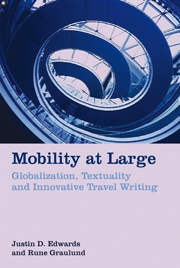Book contents
- Frontmatter
- Contents
- Acknowledgements
- Introduction: Travel Revisited
- 1 Travelling with the Ondaatje Bros.
- 2 Amitav Ghosh and Caryl Phillips: Global Travel, Then and Now
- 3 Unhomely Travels; or, the Haunts of Daphne Marlatt and W. G. Sebald
- 4 The World, My City: Home Grounds and Global Cities
- 5 Travel Histories – From Kuala Lumpur to Istanbul and Beyond
- Postscript: Still Mobile
- Bibliography
- Index
5 - Travel Histories – From Kuala Lumpur to Istanbul and Beyond
- Frontmatter
- Contents
- Acknowledgements
- Introduction: Travel Revisited
- 1 Travelling with the Ondaatje Bros.
- 2 Amitav Ghosh and Caryl Phillips: Global Travel, Then and Now
- 3 Unhomely Travels; or, the Haunts of Daphne Marlatt and W. G. Sebald
- 4 The World, My City: Home Grounds and Global Cities
- 5 Travel Histories – From Kuala Lumpur to Istanbul and Beyond
- Postscript: Still Mobile
- Bibliography
- Index
Summary
I worry that my attachment to this place will ossify my brain, that isolation might kill the desire in my gaze. Then I take comfort in reminding myself that there is something foreign in my way of looking at the city, owing to all the time I've spent reading the accounts of western travelers.
Orhan Pamuk, Istanbul 241The circumstances of when and why movements occurred is part of the unrevealed detail of a history that defies conventional historical guidelines.
Ziauddin Sardar, Consumption 26The relationship between travel writing and the historical narrative is complex and conflicted, fraught with a series of connections and tensions. Although Edward Said and Sara Mills warn us about how travel texts can disseminate discourses of difference, there is a growing demand among historians for access to travel writing as a documentary source offering unique insights into the past and allowing for nuanced understandings of cross-cultural relations. In this context, travel texts provide historical information about a range of topics, from the everyday to the extraordinary, thus complementing the contemporary historical interest in diaries, journals, letters and memoirs as records of everyday life. Indeed, reading travel texts as historical sources can supply first-hand accounts of the everyday traveller in a period, detailing key interests and themes, as well as presenting snapshots of cities, cultures and customs. In some cases, major historical events are captured by eyewitnesses; in other instances, the traveller simply relates experiences that illustrate the rise of modern tourism and the travel industry.
- Type
- Chapter
- Information
- Mobility at LargeGlobalization, Textuality and Innovative Travel Writing, pp. 165 - 197Publisher: Liverpool University PressPrint publication year: 2012



